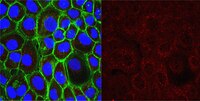MAB5434-C Sigma-AldrichAnti-Oct-1 Antibody, clone YL15, Ascites Free
Anti-Oct-1 Antibody, clone YL15, Cat. No. MAB5434-C, is a mouse monoclonal antibody that detects octamer-binding protein 1 (Oct-1) and has been tested for use in immunocytochemistry, immunohistchemistry (Parffin), Immunoflouroesencece, Western blotting, and Chromatin Immunorecipitation.
More>> Anti-Oct-1 Antibody, clone YL15, Cat. No. MAB5434-C, is a mouse monoclonal antibody that detects octamer-binding protein 1 (Oct-1) and has been tested for use in immunocytochemistry, immunohistchemistry (Parffin), Immunoflouroesencece, Western blotting, and Chromatin Immunorecipitation. Less<<Recommended Products
Overview
| Replacement Information |
|---|
Key Spec Table
| Species Reactivity | Key Applications | Host | Format | Antibody Type |
|---|---|---|---|---|
| H, M | WB, ICC, IF, IH(P), ChIP | M | Purified | Monoclonal Antibody |
| References |
|---|
| Product Information | |
|---|---|
| Format | Purified |
| Presentation | Purified mouse monoclonal IgG1κ antibody in buffer containing 0.1 M Tris-Glycine (pH 7.4), 150 mM NaCl with 0.05% sodium azide. |
| Quality Level | MQ100 |
| Physicochemical Information |
|---|
| Dimensions |
|---|
| Materials Information |
|---|
| Toxicological Information |
|---|
| Safety Information according to GHS |
|---|
| Safety Information |
|---|
| Storage and Shipping Information | |
|---|---|
| Storage Conditions | Stable for 1 year at 2-8°C from date of receipt. |
| Packaging Information | |
|---|---|
| Material Size | 100 μg |
| Transport Information |
|---|
| Supplemental Information |
|---|
| Specifications |
|---|
| Global Trade Item Number | |
|---|---|
| Catalogue Number | GTIN |
| MAB5434-C | 04055977333206 |
Documentation
Anti-Oct-1 Antibody, clone YL15, Ascites Free SDS
| Title |
|---|
Anti-Oct-1 Antibody, clone YL15, Ascites Free Certificates of Analysis
| Title | Lot Number |
|---|---|
| Anti-Oct-1, clone YL15, Ascites Free - 3487084 | 3487084 |
| Anti-Oct-1, clone YL15, Ascites Free - 4035069 | 4035069 |
| Anti-Oct-1, clone YL15, Ascites Free -Q2664688 | Q2664688 |














